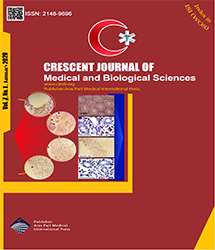| Original Article | |
| Effect of Estrogen Priming in Antagonist Cycles in Women With Poor Response to IVF Treatment | |
| Alyeh Ghasemzadeh1, Roghayeh Dehghan Zadeh1, Laya Farzadi1, Mohammad Nouri1, Alireza Souri2 | |
| 1Women’s Reproductive Health Research Center, Tabriz University of Medical Sciences, Tabriz, Iran 2Department of Epidemiology, Shahid Beheshti University of Medical Sciences, Tehran, Iran |
|
|
CJMB 2020; 7: 110–115 Viewed : 5415 times Downloaded : 6665 times. Keywords : Estrogen Priming, Gonadotropins, GnRH |
|
| Full Text(PDF) | Related Articles | |
| Abstract | |
Objectives: Despite inconsistencies in existing studies, the results of some research studies indicate that treatment with estrogen priming and gonadotropin-releasing hormone (GnRH) antagonist look promising for poor-responder patients. Materials and Methods: The study was conducted on 2 groups of poor-responder patients under treatment with GnRH antagonist and gonadotropin. Each group had 53 patients. The treatment was performed after considering the patients’ age, the number of previously failed in-vitro fertilization (IVF), antral follicles count and mean serum level of follicular stimulating hormone (FSH3), anti-Müllerian hormone (AMH), and estradiol (E2). In the intervention group, 4 mg of estradiol valerate was administered daily from the 21st day of the cycle before IVF and continued up to the second day of the cycle. Then, stimulation was initiated with human menopausal gonadotropin (HMG) and follicle-stimulating hormone (FSH) and the GnRH antagonist was implemented on the eighth day and continued until the prescription of human chorionic gonadotropin (HCG). Results: The average number of obtained large follicles (2.9±1.8 against 2.3±1.6), M2 oocytes (3.6±0.3 against 2.8±0.3) and embryo quality type II (1.3±0.2 against 0.9±0.1) and type III (0.7±0.1 against 0.3±0.1) in the intervention group was signifcantly higher compared to the control group (P value was respectively 0.05, 0.05, 0.05, and 0.01). The rate of successful pregnancy was higher in the intervention group (8.3%) than in the control group (6.7%). However, it was not statistically signifcant (P=0.50). Conclusions: Estrogen priming has positive effects on GnRH antagonist cycles with an increase in the number of large follicles and better quality oocytes and embryos. |
Cite By, Google Scholar
Google Scholar
PubMed
Online Submission System
 CJMB ENDNOTE ® Style
CJMB ENDNOTE ® Style
 Tutorials
Tutorials
 Publication Charge
Medical and Biological Research Center
About Journal
Publication Charge
Medical and Biological Research Center
About Journal
Aras Part Medical International Press Editor-in-Chief
Arash Khaki
Deputy Editor
Zafer Akan


















